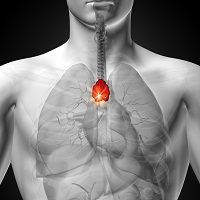Article
Recurrent Thymoma: Surgical Resection Leads to Good Outcomes
Author(s):
Thymoma is rare and most known for its presence in 15% of patients who have myasthenia gravis. Thymoma tumors can be quite large. Surgery is the mainstay of treatment for thymoma, but when thymoma recurs (as it does in 10% to 30% of patients), the best course of action is often unclear.

Thymoma (tumors originating from the epithelial cells of the thymus) is rare and most known for its presence in 15% of patients who have myasthenia gravis. Thymoma tumors can be quite large. Surgery is the mainstay of treatment for thymoma, but when thymoma recurs (as it does in 10% to 30% of patients), the best course of action is often unclear. A new study published in the December 2014 issue of the Journal of Thoracic Oncology examines patients with relapse and links long-term outcomes to treatment strategies and clinicopathological features.
The authors analyzed databases from 3 Italian tertiary thoracic surgery centers. They identified 81 patients who experienced a recurrent thymoma after radical thymectomy over a 12 year period (2001-2013). Thymomas were staged using the Masaoka surgical and pathological criteria. Experienced pathologists reassessed the initial thymoma and its relapse using WHO classification. The researchers determined 5 years and 10 years survival and disease-free survival after initial thymectomy and after treatment of recurrent thymoma.
The mean follow-up after recurrence onset was about 5.5 years. Most thymoma relapse was locoregional and it occurred in the mediastinum and pleura in 73% of patients.
Among study subjects, 54 relapsed patients (67%) were diagnosed with myasthenia gravis, and 14 had other paraneoplastic conditions. Sixty-one patients (75%) underwent surgery and 14 (17%) received radiotherapy and/or chemotherapy.
Adjuvant therapy with either chemotherapy or radiotherapy had no effect on prolonging the disease-free survival; patient mean survival was more than 8 years regardless.
Overall, the 5- and 10-year survival rates after the initial thymectomy were 94.8% and 71.7%, respectively, while the 5- and 10-year survival rates after the treatment of the recurrence at the thymic level were 73.6% and 48.3%, respectively.
The site of recurrence (hematogenous diffusion) seems to be associated with a higher risk of re-relapse.
WHO upgrade (from “low-risk” WHO classes at thymectomy to “high-risk classes” at relapse) was warranted in almost 40% of patients but did not correlate with worsening prognosis.
Long-term survival is generally robust in thymoma patients, especially after complete surgical resection.




